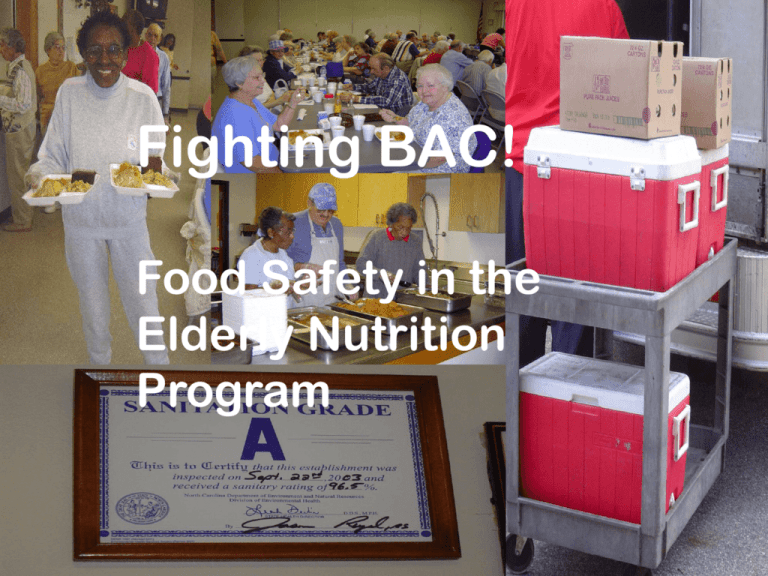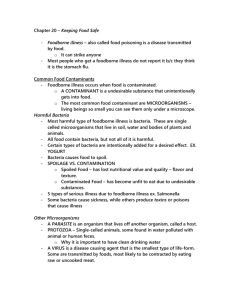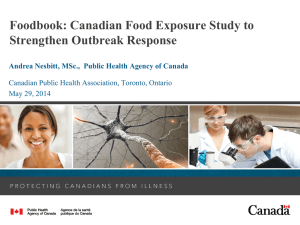Fighting BAC! - Food Safety Site
advertisement

Fighting BAC! Food Safety in the Elderly Nutrition Program 1 — LOOKING AT THE ENEMY Every year: – 76 million people get foodborne illness – 325,000 are hospitalized – 5000 die 1 in every 4 Americans will get foodborne illness this year. Who is susceptible? Older adults (65 years and older) Pregnant women Very young children (2 years or younger) Individuals with compromised immune systems Individuals who are malnourished What causes foodborne illness? Eating unsafe food Food becomes unsafe primarily because of microorganisms, such as: – Bacteria – Viruses – Parasites Any food can cause illness if it is not handled safely. Common causes of foodborne illness Improper cooling/holding of foods Not washing hands properly Using food from unsafe sources Cross-contamination Improper cooking How do bacteria grow? Bacteria double under ideal conditions every 30 minutes. – At 12:00 noon you can have 10 bacteria in a food – By 5:00 p.m. there could be 10,240 bacteria. – This is enough to make one sick with foodborne illness What are ideal conditions for bacteria to grow? Potentially hazardous food (PHF), which are: – low acid – moist – some protein Unsafe temperature between 45oF and 140oF PHF at unsafe temperatures for at least two hours Activity — Potentially Hazardous Foods Look at your site’s menu and highlight those foods that are potentially hazardous. These foods need to be at 45oF or colder or 140oF or hotter. The only way to determine if these foods are at the proper temperature is to use a thermometer. Viruses and Parasites Viruses are believed to be the number one cause of foodborne illness. – Viruses do not grow in food like bacteria do. – Viruses can contaminate any food, not just potentially hazardous foods. Parasites do not cause many cases of foodborne illness in the U.S. To Fight BAC! against foodborne illness: CLEAN: Wash hands and surfaces often SEPARATE: Don’t cross-contaminate COOK: Cook foods to proper temperatures CHILL: Refrigerate foods promptly 2 — RECEIVING Only purchase food from an approved source, such as: – permitted foodservice operation – grocery store – foodservice wholesale supplier Inspect before you accept to be certain that the food meets your food safety standards. Activity — Accept or Reject? Which of these foods would you accept and why? Individual cartons of milk that are at 48oF A sheet cake that is uncovered o Turkey and dressing at 132 F o Cooked corn that is at 139 F o Tossed salad that is at 44 F Develop a Back-up Plan Many of the foods on the previous slide had to be rejected. You need a back-up plan in place so that if you have to reject you will still be able to feed the participants. Share with the group what you would do if you had to reject a shipment of food. 3 — STORAGE All food must be: – covered and clean – in its original packaging or labeled – marked with time and date of receipt – stored at the proper temperature – use a storage chart to determine how long you can keep Chemical Storage Store chemicals separate from food. Keep them close to where they are needed. Activity — What’s My Storage Temperature? At what temperature do each of these foods need to be stored: Individual containers of milk Chocolate chip cookies Turkey and dressing to be delivered to a home Tossed salad with carrots and tomatoes Rolls 4 — PREPARATION Do not work if you are ill. Wash hands with antibacterial soap and water before handling food. Properly use singleuse gloves. Handwashing Sink Clean Accessible Stocked with soap and single-use paper towels PREPARATION Use safe ingredients. Wash fresh fruits and vegetables with lukewarm water. Prevent crosscontamination. Activity — How well do you wash your hands? Put a dime-size amount of the GloGermTM lotion onto your hands. Rub all over like you would hand lotion. Wash your hands with soap and water. Return to a darkened room and check how well you did by putting your hands under an ultra-violet black light. 5 — COOKING Proper cooking kills harmful bacteria and parasites that are naturally present in raw foods. Cooking will not necessarily destroy toxins or viruses. Measuring Food Temperatures 1. Use a food thermometer that has a temperature range between 0-220oF. 2. Each day check the accuracy of your food thermometer(s) in ice water. 3. Clean and sanitize the thermometer before each use. 4. Insert into the thickest part of the food or into the center of the food. Activity — What’s My Cooking Temperature? To what temperature do you cook each of these foods? Frozen ground beef patties Turkey roast Commercially canned spaghetti sauce Chocolate chip cookies Vegetable soup Creamed corn Activity — Calibrating Thermometers Divide the group into teams. Give each team a thermometer and a glass filled with crushed ice and water. Have each team check the accuracy of their thermometer. If not at 32oF, then have them calibrate. 6 — SERVING Keep hot foods at 140oF or hotter. Keep cold foods at 45oF or colder. Use cleaned and sanitized serving utensils. Wear clean clothes and keep hair restrained. 7 — LEFTOVERS Congregate nutrition site should not be cooling hot foods or reheating them because: – the sites do not have commercial equipment to properly cool foods. Review the leftover policy that appears in the participant manual. Participants taking home leftovers Improperly cooled food = unsafe food Improperly cooled food must be discarded. During cooling, spores could grow. Some form toxins Reheating, even to boiling temperatures, will not necessarily destroy these toxins. 8 — CLEANING AND SANITIZING CLEANING = removing dirt and debris SANITIZING = killing 99.999% of harmful bacteria that might still be on the surface. Cleaning and Sanitizing Steps 1. Wash surface with soapy water. 2. Rinse with clean water. 3. Immerse rinsed item into a properly prepared sanitizing solution. 4. Let soak for 2 minutes. 5. Remove and air-dry. 6. Store item in clean location. Chlorine sanitizing solution 1 teaspoon unscented chlorine bleach + 1 gallon, warm not hot water = Sanitizing solution at 50 ppm Activity — Preparing sanitizing solution Divide the group into teams. Give each team a spray bottle and bleach. Have them prepare sanitizing solution. Have each group measure the concentration. Demonstrate the proper procedure for preparing sanitizing solution. 9 — HOME DELIVERED MEALS Securely package and seal each food. Hold food at >140oF or <45oF. Use food delivery carriers that meet NSF standards. Deliver meal within two hours from the time the meal was placed in carrier. Clean and sanitize carriers after each use. “Foodborne illness is nearly 100% preventable if food is handled safely from the time it is received until the time it is served.” Photos taken at: Garner Senior Center Garner, NC





